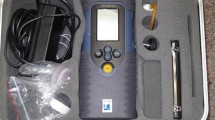Abstract
Anesthetic level measurement is a real time process. This paper presents a new method to measure anesthesia level in surgery rooms at hospitals using a QCM based E-Nose. The E-Nose system contains an array of eight different coated QCM sensors. In this work, the best linear reacting sensor is selected from the array and used in the experiments. Then, the sensor response time was observed about 15 min using classic method, which is impractical for on-line anesthetic level detection during a surgery. Later, the sensor transition data is analyzed to reach a decision earlier than the classical method. As a result, it is found out that the slope of transition data gives valuable information to predict the anesthetic level. With this new method, we achieved to find correct anesthetic levels within 100 s.







Similar content being viewed by others
References
Marshall, B. E., and Lockenfger, D. E., General anesthetics. In: Brunton, L., Lazo, J., and Park, K. (Eds.), Goodman and Gilman’s The Pharmacological Basis of Therapeutics, 8th edition. Pergamon, Oxford, UK, pp. 285–311, 1990.
Mahfouf, M., Asbury, A. J., and Linkens, D. A., Unconstrained and constrained generalized predictive control of depth of anesthesia during surgery. Control Eng. Prac. 11:1501–1515, 2003.
Becker, K., Thull, B., Kasmacher-Leidinger, H., Stemmer, J., Rau, G., Kalf, G., and Zimmermann, H., Design and validation of an intelligent patient monitoring and alarm system based on fuzzy logic process model. Art. Int. Med. 11:33–53, 1997.
Vefghi, L., and Linkens, D. A., Internal representation in neural networks used for classification of patient anesthetic states and dosage. Comput. Methods Programs Biomed. 59:75–89, 1999.
Saraoğlu, H. M., Şanlı, S., Fuzzy Logic based anesthetic depth control. In: 2003 ICIS International Conference on Signal Processing, Çanakkale, Turkey, pp. 24–26, 2003.
Saraoğlu, H. M., and Edin, B., E-Nose system for anesthetic dose level detection using artificial neural network. J. Med. Syst. 6:475–482, 2007.
Saraoğlu, H. M., and Şanlı, S., A fuzzy logic-based decision support system on anesthetic depth control for helping anesthetists in surgeries. J. Med. Syst. 6:511–519, 2007.
Başova, T. V., Taşaltın, C., Gürek, A. G., Öztürk, Z. Z., and Ahsen, V., Mesomorphic phthalocyanine as chemically sensitive coatings for chemical sensors. Sens. Actuators B. 96:70–75, 2003.
Özmen, A., Ebeoğlu, M. A., Tekce, F., Taşaltın, C., and Öztürk, Z. Z., Finding the composition of gas mixtures by a phthalocyanine coated QCM sensor array and an artificial neural network. Sens. Actuators B. 115:1450–454, 2006.
King, H. W., Piezoelectric sorption detector. Anal. Chem. 36:1735–1739, 1964.
Temurtas, F., Fast detection of hazardous organic gases in the ambient air using adaptive neuro-fuzzy inference systems. Int. J. Environ. Pollut. 28:3/4352–363, 2006.
Gulbag, A., and Temurtas, F., A study on transient and steady state sensor data for identification of individual gas concentrations in their gas mixtures. Sens. Actuators B. 121:2590–599, 2007.
Acknowledgment
This research is supported by TUBITAK (104E053) and DPU (2004-6). The QCM sensors were developed and provided by Department of Materials and Chemical Technologies, Marmara Research Center, TUBITAK. Evliya Çelebi State Hospital-Kütahya administration allowed us to conduct the experiments.
Author information
Authors and Affiliations
Corresponding author
Rights and permissions
About this article
Cite this article
Saraoğlu, H.M., Özmen, A. & Ebeoğlu, M.A. Anesthetic Level Prediction Using a QCM Based E-Nose. J Med Syst 32, 251–257 (2008). https://doi.org/10.1007/s10916-008-9130-3
Received:
Accepted:
Published:
Issue Date:
DOI: https://doi.org/10.1007/s10916-008-9130-3




